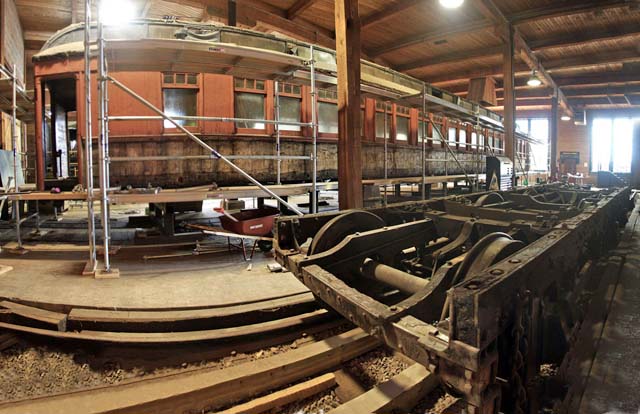
Early Days of Western Canada
Calgary Alberta - "The train ride to Alberta took us across most of Canada. The trains were dirty and very short on all the amenities of
daily life. When I entered Grade 1, the class was asked to draw a picture of a train. I did so and coloured the whole train black. The teacher spanked me for
not using other colours, and for not taking a realistic view of trains. My mother later explained to her what my experience of trains had
been."
The above recollection of William Kreeft, a little boy seeing the western prairies for the first time through a train window, is one of the favourite stories
told at the Canadian Museum of Immigration.
Located at Halifax's Pier 21, where more than a million immigrants passed in the early 20th century, the museum is a reminder of how Canada was, and continues
to be, built on immigration.
Kreeft was one of many Europeans who first arrived at one of several eastern Canadian ports, only to be dispatched by rail to their new homes, with those trips
lasting up to a week.
With only a $25 surety to show officials they wouldn't be destitute when disembarking at their ultimate destination, their $7 train fare wouldn't qualify them
for the first class cars of the train.
Instead, these hopeful new Canadians instead climbed aboard the Colonist Cars, no-frills lodgings with berths consisting of hard wooden benches and a pull down
bed, along with coal burning stoves at each end of the cars where passengers cooked meals.
For more than a half-century, one of those Colonist Cars has been a treasured feature in the collection of Calgary's Heritage Park Historical
Village.
Heritage Park officials have been proud to host what was thought to be Colonist Car number 2658, one of only two built by the CPR that still
exist.
A recent restoration of the car, however, unearthed a major discovery, it was not car 2658, but car 1201, one made years earlier, and thus, one that would have
carried countless more immigrants to their Western Canadian destinations.
"When we started the restoration, peeling back the layers, we realized it was even older," says Alida Visbach, Heritage Park's president and
CEO.
"It was one of the first to come off the lines, which makes it an even more rare artifact."
Built at Montreal's Angus Shops in 1905, the car, says Visbach, "is nothing less than a national treasure."
Over the next two years, workers will lovingly restore number 1201 to its original state.
Once completed, it will be a permanent exhibit at the park.
To both celebrate its restoration and Canada's 150th birthday, in 2017 Heritage Park will mount a travelling exhibition, which will begin at Halifax's Pier 21
next September, eventually making its way to Calgary by December, 2017.
Called "A National Pride: Alberta's Gift to the Nation", the exhibition will tell Canada's immigrant story, with a Western flavour, using
personal stories, historical milestones, interactive displays, and a theatrical performance to take audiences back in time.
The project is in partnership with BMO Financial Group, the government of Alberta, the City of Calgary, and with support from Calgary philanthropist Joan
Snyder.
"It is the story of Canada, how we became who we are today, with the whole mosaic of cultures," says Visbach, whose own parents arrived at Pier 21
from Holland just after the Second World War.
"We all came from somewhere else, with the exception of our First Nations."
Trains not only delivered those Canadians, Canadian Pacific Railway (CPR) and the Canadian National Railway were given, thanks to the "Railway Acts"
of the late 19th century, the power to sponsor those immigrants into the country.
The first, biggest wave to the West was roughly between 1896 and 1914, much of it prompted by enticing advertisements by the two rail companies to lure
newcomers with 160 acres of free land if they'd help populate provinces like Alberta.
In that time period, the CPR, which built 1,000 of the cars, transported more than three million people to points west of the Canadian Shield.
The first decade of the 20th century saw the country's population grow from 5.3 million to 7.2 million, largely thanks to immigration from Europe.
"The Colonist Cars could accommodate 72 people, in rather tight seating arrangements," says Susan Reckseidler, Heritage Park's manager,
interpretation.
"Some people brought cattle, which were kept in cattle cars, while some brought their piano. It's interesting to think about what you'd leave behind, and
what prized possession you would want on the long journey."
Along with telling the stories of those early immigrants, "A National Pride" will also collect stories from other Canadians, whether it's their own
immigrant experience or that of parents or grandparents.
"Rail transport helped to make Canada the multi-cultural mosaic it is today," says Visbach.
"We have been an open and welcoming country, which we continue to this day, we still welcome and embrace newcomers from all over the
world."
This exhibit, along with Colonist Car number 1201, celebrates that diversity.
"It is our gift to Canada," she says.
Valerie Fortney.
provisions in Section 29 of the Canadian
Copyright Modernization Act.

